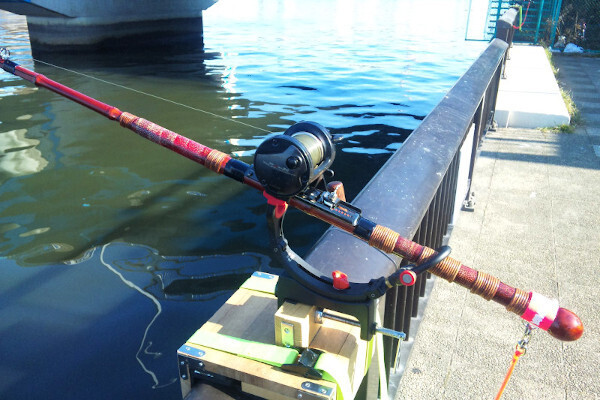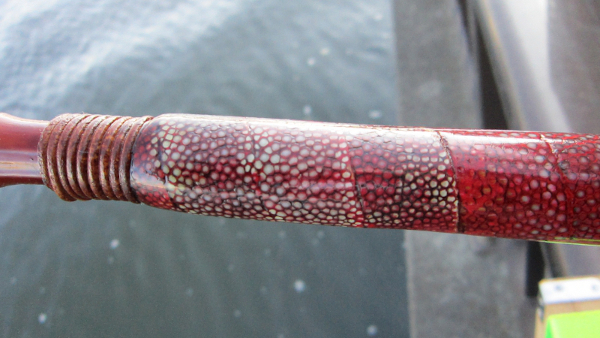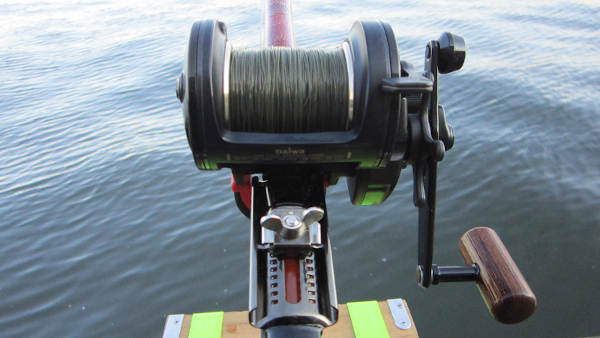Namitsugi Cob | 29 Jan. 2012
While organizing bamboo rods with my daughter Saki, we came across materials I had assembled about ten years ago for a kawahagi (filefish) rod. It consisted of two sections of my favorite Hotei bamboo with a thick yet moderately tapered design, and the tip was paired with whale mustache. Considering the excellent quality of the bamboo, I thought of turning it into a carp fishing rod. As an experiment, I replaced the whale mustache tip with a solid tip, and to my surprise, it had a similar action to the SS3. Jokingly, we decided to create a bamboo carp rod and name it SS4. It had the same light action as SS1. The only concern was that it was originally a kawahagi rod, and I worried about the reinforcement of the joint core. While the kawahagi rod have an iron core for reinforcement, this rod was reinforced with about three layers of glass material as the core. I wondered if it would withstand the strain when a fish is hooked. Well, it was all in good fun, so we started the construction without worrying too much.

Sumida River Special 4
Similar to SS3, I first reinforced the joint by wrapping it with silk thread and then sealing it with lacquer. This method was easier compared to full wrapping, which made the process more enjoyable. Next, I applied a dark-colored lacquer for the body. I wanted to achieve a deep color, so I applied multiple coats of "transparent Urushi" using a brush.
While contemplating a change in decoration for the grip and joint wrapping, I remembered the technique of sharpening sharkskin (ray skin). It is a method used in Japanese sword scabbards, resulting in a unique irregular dot pattern after smoothing out the rough nodules. Although I had doubts about its suitability for a fishing rod, I decided to try it as a joke. To be more specific, it was sharkskin used in high-quality wasabi graters. When you touch it, you can feel the numerous rough nodules. I smoothed them out with sandpaper. Although I referred to it as "sharkskin," it is actually "ray skin," and I purchased a piece from Tokyu Hands.
For the joint wrapping, instead of simply wrapping the skin, I decided to cut it into approximately 20mm wide strips and tightly wrap them in a spiral, aiming for strength. As for the grip, it was merely a decorative element, so I cut the skin into a rectangular shape and wrapped it around.
After firmly securing them with adhesive, I applied lacquer to fill the gaps between the nodules. Then came the smoothing process, but the nodules were hard... The sandpaper I usually use couldn't catch the edges, so I tried using sandpaper for metal, but it still didn't work. In the end, I resorted to grinding them with a metal file. However, they were tough. I can't remember how many days I spent filing them flat... It was about two hours of work per day, but it felt like I was fighting with the sharkskin for over a week.
Since the result turned out better than expected, I decided to wrap rattan around the sides with the skin. However, the bamboo was thick, and it would require a lot of expensive rattan. In the end, I gave up and decided to use leather cords instead. Leather cords are not typically used for traditional Japanese rods, but this was also part of the joke. I used thick cords for the grip. This was intended to provide better grip rather than just decoration. For the joint wrapping, I used thin leather cords, and the result was similar to using rattan. I applied lacquer to the leather cords (or rather, let it soak in), secured them firmly, and completed the lacquering process.

Sharpening sharkskin (ray skin)
Next, I attached the reel seat and guides. It was challenging to find a reel seat for ishidai (striped beakfish) fishing; the octopus seat was not readily available. I searched on the internet and managed to find one from the manufacturer along with the guides. Although it was somewhat expensive, it was well-made, and I felt confident in using it. Especially for the guides, I wanted to use high-performance ones made of materials with minimal friction. I wouldn't forgive myself if the line broke during a fight with a large fish just because I tried to save money. The process was similar to SS3, but at this point, I started rushing and became careless in my work due to my impatience for completion. Although it was not entirely due to impatience, as there was a lack of time until the SS4 debut, it became a rushed job. As a result, it ended up being somewhat sloppy.

Reel seat for ishidai fishing
After allowing the lacquer to dry thoroughly, I finished it with Tsubaki (camellia) oil. Sufficient oil is necessary to prevent the bamboo from splitting, so caution is required.
On 9 Jan. 2012, the SS4 made its debut. The sinker was the usual 130g. First, I tried overhead casting to test its long-distance capabilities. It had a slightly faster action than I anticipated, but it was incredibly easy to cast. Next, I attached a gobie and cast it using a sidearm cast. It was very easy to cast, and I had excellent control from the release to the lure's landing.
The first bite on the SS4 didn't hook, and it slipped off. On the second bite, it hooked perfectly. While still concerned about the joint's strength (nested sections), I applied tension to the line and felt satisfied with how well it handled. Perhaps due to the small size of the fish, I felt slightly unsatisfied, but I managed to land it successfully. I had to be cautious not to raise the rod too high during the landing, paying more attention compared to a fiberglass rod.
Well, this rod was created as a hobby, just for fun. It's a tricky rod that requires careful handling, but I look forward to the day when I hook a big catch. I will cherish it as I use it in the winter Sumida river fishing.